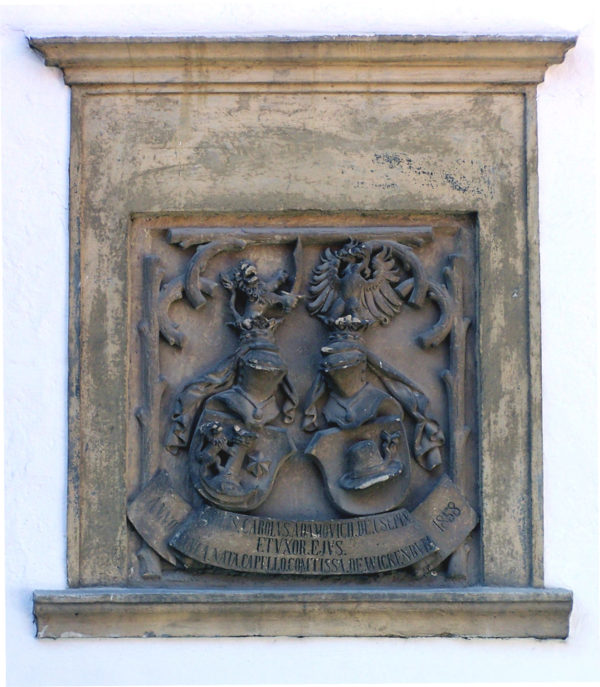
Arms of alliance of the Adamovich and Wickenburg families in Velenje Castle
VELENJE, CASTLE
Location of the coat of arms: façade
During its long history, Velenje Castle passed through several owners and was rebuilt on many occasions. One of the last major rebuilding projects was undertaken in the second half of the nineteenth century by Karl von Adamovich (1829–1874) and his wife Bianca, née Countess Wickenburg (1837–1912), who became its owners in 1858. The work included installing larger windows, reconstructing the mural crown with superstructures, and changing the exterior courtyard on the southeastern side by giving its extensions gable ends with characteristic tower-shaped articulations. The new owners marked their rebuilding work with a heraldic plaque built into the southern wall of the inner courtyard. The plaque displays the arms of alliance of the Adamovich and Wickenburg families; however, the Wickenburgs’ coat of arms is not depicted in its entirety but rather only as the basic family coat of arms (Germ. Stammwappen). Below both coats of arms runs the inscription: NOBILIS CAROLVS ADAMOVICH DE CSEPIN ET VXOR EJVS BIANCA NATA CAPELLO COMTISSA DE WICKENBVRG ANNO 1858. The castle remained in the hands of the Adamovich family until 1918, when it was sold to their relative Karl Count von Coronini.
According to some information, the family of Karl Adamovich originated in the town of Chiprovtsi in northwestern Bulgaria, whence it is believed to have first settled in Bosnia and then Slavonia. The Adamoviches already viewed themselves as nobility in the seventeenth century; in 1714, Hungarian King Charles III (Emperor Charles VI) also granted Paul Adamovich the rank of Hungarian–Croatian nobility, and in 1770 Maria Theresa granted his grandson Johannes Kapistran the predicate de Csepin after his estate of Čepin near Osijek. The sons of Johannes Kapistran divided the family into two branches—the older Paul (1760–1801) continued the Čepin branch, whereas the branch of his younger brother Anton Casper (1762–1829) obtained its name after the estate of Tenje southeast of Osijek. The castellan from Velenje, Karl Adamovich, belonged to the Tenje branch as the grandson of Anton Caspar.
The family of Karl’s wife Bianca was first named Capello—or, rather, Capellini—as confirmed by the hat (Ital. capello) in their original coat of arms. The founder of the family was Francesco Maria Capellini, called Stechinelli (1640–1694), who moved from his native Rimini to Celle near Hannover and built himself a splendid career in the postal services at the local ducal court. He was ennobled in 1688, with his predicate Wickenburg referring to one of his estates—Wieckenberg, now part of the town of Wietze in Lower Saxony.
Literature:
Ravnikar, Tone: Grad Velenje: skica usode stavbe in njenih prebivalcev. Velenje 2002, pp. 55, 56.
Stopar, Ivan: Grajske stavbe v vzhodni Sloveniji. Med Solčavskim in Kobanskim (vol. 4). Ljubljana: Viharnik, 1993, p. 128.
Šćitaroci, Mladen and Bojana: Slawoniens Schlösser. Von Zagreb bis Vukovar. Graz/Stuttgart 2000, pp. 106–109, 300–303, 367, 368, 397, 398.
